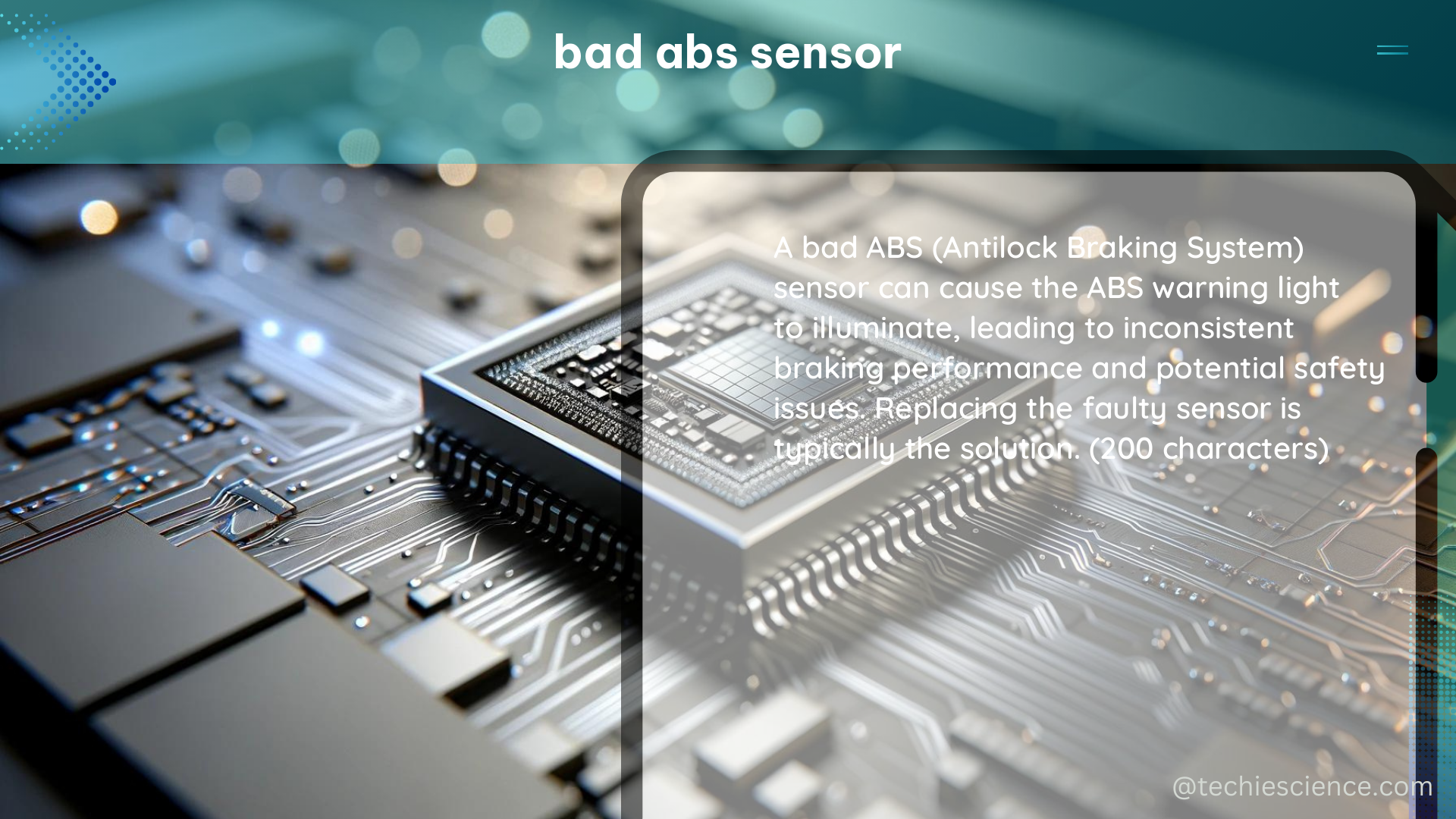The anti-lock braking system (ABS) is a crucial safety feature in modern vehicles, and the ABS sensor, also known as the wheel speed sensor, plays a vital role in its operation. This sensor is responsible for measuring the rotational speed of each wheel and transmitting this information to the ABS control unit, which then uses the data to prevent the wheels from locking up during hard braking, ensuring stability and control of the vehicle.
Understanding ABS Sensors: Active vs. Passive
There are two main types of ABS sensors: active and passive. Active sensors require a power supply from the control unit and generate an output signal when a magnetic field changes, while passive sensors do not require a separate power supply and generate a signal based on the rotation of a toothed wheel.
Active ABS sensors typically have a resistance value between 800-2,000 ohms, while passive sensors have a resistance value between 400-1,000 ohms. The frequency and amplitude of the signal generated by the ABS sensor are directly related to the wheel speed, and this signal is quantifiable and measurable, making it possible to diagnose faults in the ABS system.
Diagnosing a Faulty ABS Sensor

When it comes to diagnosing a faulty ABS sensor, there are several measurable and quantifiable data points that can be used. Here are some key steps to follow:
Resistance Measurements
One of the first things to check is the resistance of the ABS sensor. Using a multimeter, measure the resistance between the two terminals of the sensor. Compare the measured value to the manufacturer’s specifications to determine if the sensor is within the acceptable range. If the resistance is outside the specified range, the sensor may be faulty and in need of replacement.
Signal Analysis
In addition to resistance measurements, the signal generated by the ABS sensor can also be analyzed to diagnose faults. A scan tool or diagnostic device can be used to measure the frequency and amplitude of the signal, which can then be compared to the manufacturer’s specifications to determine if the sensor is functioning properly.
For example, a healthy active ABS sensor should generate a signal with a frequency of around 1-10 kHz, depending on the vehicle’s speed. The amplitude of the signal should also be within the manufacturer’s specified range, typically between 0.5-5 volts.
If the frequency or amplitude of the signal is outside the acceptable range, it may indicate a problem with the ABS sensor or the associated wiring and connections.
Wheel Speed Comparison
Another way to diagnose a faulty ABS sensor is to compare the wheel speed readings from each sensor. If one wheel is consistently reporting a significantly different speed than the others, it may indicate a problem with that sensor.
You can use a scan tool or diagnostic device to read the wheel speed data from each sensor and compare the values. If one sensor is reporting a significantly different speed, it may be a sign of a faulty sensor that needs to be replaced.
Sensor Mounting and Condition
Finally, it’s important to inspect the physical condition of the ABS sensor and its mounting. Check for any signs of damage, such as cracks, corrosion, or loose connections. Ensure that the sensor is properly mounted and that the impulse ring (the toothed wheel that the sensor reads) is in good condition and free of debris or damage.
Replacing an ABS Sensor
If a fault is detected in the ABS sensor, it may be necessary to replace the sensor. When replacing an ABS sensor, it is important to follow the manufacturer’s installation instructions to ensure proper operation. Incorrect installation can lead to damage to the bearing and impulse ring, which can result in premature failure of the ABS system.
Some key considerations when replacing an ABS sensor include:
- Ensuring the new sensor is the correct part number for the vehicle
- Properly aligning the sensor with the impulse ring
- Tightening the sensor to the specified torque
- Checking for any damage to the impulse ring and replacing it if necessary
- Verifying the sensor is functioning properly after installation by checking the resistance and signal output
Conclusion
The ABS sensor is a critical component in a vehicle’s anti-lock braking system, and understanding how to diagnose and troubleshoot issues with this sensor is essential for maintaining the safety and performance of your vehicle. By following the steps outlined in this guide, you can effectively identify and address any problems with your ABS sensor, ensuring your vehicle’s braking system continues to function as intended.
References:
- BRAKE DISCS AND WHEEL SPEED SENSORS IN ABS SYSTEMS – HELLA PAGID
https://www.hella-pagid.com/hellapagid/assets/media/Brake_Disc_ABS_PAGID_EN.pdf - Check and change ABS and wheel speed sensors – HELLA
https://www.hella.com/techworld/us/Technical/Sensors-and-actuators/Check-change-ABS-sensor-4074/ - How to get ABS LIVE DATA from your car in 2 minutes. – YouTube
https://www.youtube.com/watch?v=bEXaEL4efKA - Fooling an ABS sensor? – Chevy Impala SS Forum
https://www.impalassforum.com/threads/fooling-an-abs-sensor.1005321/ - Testing ABS Wheel Sensors – iRV2 Forums
https://www.irv2.com/forums/f22/testing-abs-wheel-sensors-400349.html

The lambdageeks.com Core SME Team is a group of experienced subject matter experts from diverse scientific and technical fields including Physics, Chemistry, Technology,Electronics & Electrical Engineering, Automotive, Mechanical Engineering. Our team collaborates to create high-quality, well-researched articles on a wide range of science and technology topics for the lambdageeks.com website.
All Our Senior SME are having more than 7 Years of experience in the respective fields . They are either Working Industry Professionals or assocaited With different Universities. Refer Our Authors Page to get to know About our Core SMEs.